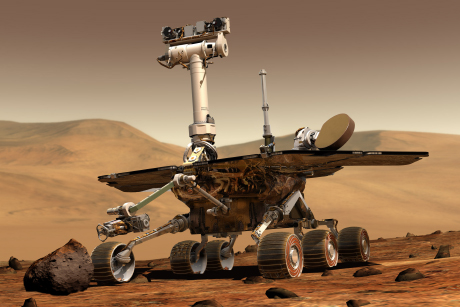Mars rover sets record after logging more than 25 miles

NASA’s Mars rover Opportunity now holds the off-Earth roving distance record after surpassing 25 miles of driving on the red planet since 2004. The previous record was held by the Soviet Union’s Lunokhod 2 rover, which explored the moon.
A drive of 157 feet July 27 put Opportunity’s odometer at 25.01 miles. This month’s driving brings the rover southward along the western rim of Endeavour Crater, which is 14 miles in diameter. Each day’s drive by Opportunity sets a new record for longest travel on wheels on a world other than Earth.
“Opportunity has driven farther than any other wheeled vehicle on another world,” said Mars Exploration Rover Project Manager John Callas, of NASA’s Jet Propulsion Laboratory, Pasadena, Calif. “This is so remarkable considering that Opportunity was intended to drive about 1 kilometer and was never designed for distance. But what is really important is not how many miles the rover has racked up, but how much exploration and discovery we have accomplished over that distance.”

Opportunity had driven more than 20 miles before arriving at Endeavour Crater in 2011. On this crater’s rim, it has examined outcrops containing clay and sulfate-bearing minerals. The sites are yielding information about ancient environments with milder water than the acidic, wet environment that left evidence Opportunity discovered at its landing site.
If the long-lived rover keeps working long enough to match the distance of a marathon footrace – 26.2 miles – it will be nearing the next major investigation site that the mission’s scientists have chosen: “Marathon Valley.” Observations from spacecraft orbiting Mars suggest several clay minerals are exposed close together there. The site is a valley with steep slopes where the relationships among different layers may be evident.
The Lunokhod 2 rover, which landed on Earth’s moon Jan. 15, 1973, drove about 24.2 miles in less than five months.
“The Lunokhod missions still stand as one of the signature accomplishments of what I think of as the first golden age of planetary exploration, the 1960s and ’70s,” said Steve Squyres, Cornell professor of astronomy and principal scientific investigator for NASA’s twin rovers mission. “We’re in a second golden age now, and what we’ve tried to do on Mars with Spirit and Opportunity has been very much inspired by the accomplishments of the Lunokhod team on the moon so many years ago.”
As Opportunity approached the 1973 mission’s mileage record earlier this year, the rover team chose the name Lunokhod 2 for a crater about 20 feet in diameter on the outer slope of Endeavour’s rim on Mars.
The Mars Exploration Rover Project is one element of NASA’s ongoing and future Mars missions preparing for a human mission in the 2030s.
Get Cornell news delivered right to your inbox.
Subscribe